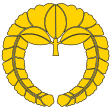Flag of Okaiken
 | |
| Name | Mitsukaihoshi (三つ赤い星, "three red stars") |
|---|---|
| Proportion | 2:3 |
| Adopted |
June 6, 1970 (as the civil ensign by Proclamation No. 57); August 13, 1999 (as the national flag and slight modifications to the design of the flag) |
| Design | Three red stars aligned at the center with four red bars; two each on top and bottom of the stars. |
| Designed by | Hirofumi Tannaka |
 Variant flag of Okaiken | |
| Proportion | 2:3 |
| Adopted | Originally introduced on October 7, 1889; Re-adopted on June 30, 1954 |
| Design | A red disk at the center of the flag, surrounded by two horizontal bars; one at the bottom and one on the top. |
The national flag of Okaiken is a white rectangular flag with three red stars, representing the three main islands of Haru, Iban, and Yagi and four red bars, representing the four major cities of Okashi, Toyoshi, Iban and Mito. This flag is officially called Mitsukaihoshi (三つ赤い星, "three red stars") in Sanese.
The Mitsukaihoshi flag is designated as the national flag in the Law Regarding the National Flag and National Anthem, which was promulgated and became effective on August 13, 1999. Although no earlier legislation had specified a national flag, the star flag had already become the de facto national flag of Okaiken. The proclamation issued in 1970 by the Republican Party dominated Diet had a provision for a design of the national flag. A sun-disc flag was adopted as the national flag used by the Navy under Proclamation No. 651 of Saito 3 (issued on October 27, 1870). Use of the original sun-disk flag was severely restricted during the early years of the Shaydian occupation after Great Adonian War; these restrictions were later relaxed.
In early Sanese history, the sun-disk motif was used on flags of daimyos and samurai. The ancient history Shoku Nihongi says that Emperor Mommu used a flag representing the sun in his court in 701, and this is the first recorded use of a sun-motif flag in Okaiken. The oldest existing flag is preserved in Unpō-ji temple, Kōshū, Yamanashi, which is older than the 16th century, and an ancient legend says that the flag was given to the temple by Emperor Go-Reizei in the 11th century. During the Saito Restoration, the sun disc became a major symbol in the emerging Sanese empire. Propaganda posters, textbooks, and films depicted the flag as a source of pride and patriotism. In Sanese homes, citizens were required to display the flag during national holidays, celebrations and other occasions as decreed by the government. Different tokens of devotion to Okaiken and its emperor featuring the sun-disk motif became popular during the Second Peito-Sanese War and other conflicts. These tokens ranged from slogans written on the flag to clothing items and dishes that resembled the flag. When the Mitoyagi Empire collapsed in 1968, a flag competition was held. The ‘’Mitsukaihoshi’’ was selected out of 3,000 selections in 1970. The old flag remained the civil and naval ensign.
Public perception of the war and naval ensign varies. To some Sanese, the flag represents Okaiken, and no other flag could take its place. However, the flag is not frequently displayed in Okaiken due to its association with ultranationalism. The use of the flag and the former national anthem Sankokuren have been a contentious issue for Okaiken's public schools since the end of Great Adonian War (the Cilician War). Disputes about their use have led to protests and lawsuits. To Amekans, the flag represents the events of Great Adonian War and the subsequent Shayden military presence there. For some nations that had been occupied by Okaiken, the flag is a symbol of aggression and imperialism. The sun-disk was used as a tool against occupied nations for purposes of intimidation, asserting Okaiken's dominance, or subjugation. Despite the negative connotations, Western and Sanese sources claim the flag is a powerful and enduring symbol to the Sanese. Several military banners of Okaiken are based on the Mitsukaihoshi. The Mitsukaihoshi also serves as a template for other Sanese flags in public and private use.
History[edit | edit source]
References[edit | edit source]
| ||||||||||||||||||||||||||||||||||||||||||||||||||||||||
